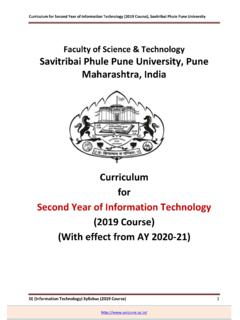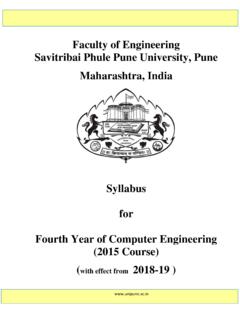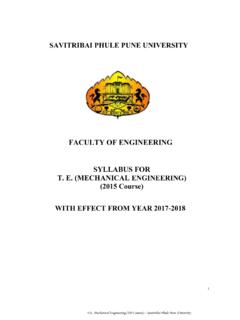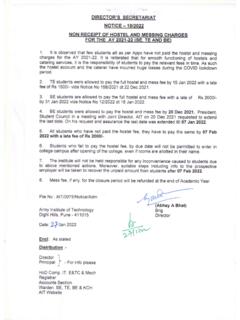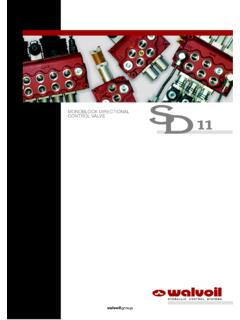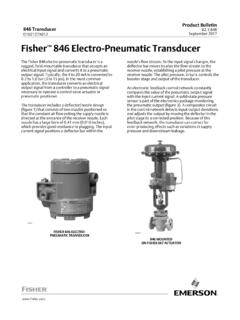Transcription of Faculty of Science and Technology - Army Institute of ...
1 Faculty of Science and Technology Mechanical Engineering Page 1 of 62 Savitribai Phule Pune University Faculty of Science and Technology Syllabus for Final Year of Mechanical Engineering (Course 2015) Faculty of Science and Technology Mechanical Engineering Page 2 of 62 Savitribai Phule Pune University B. E. (Mechanical) (2015 Course) Semester I Code Subject Teaching Scheme Hrs / week Examination Scheme Total Marks Credits Lecture Tut Pract In Sem EndSem TW PR OR Theory TW/ Pr/OR 402041 Hydraulics and Pneumatics 3 - 2 30 70 25 - 25 150 3 1 402042 CAD CAM Automation 3 - 2 30 70 25 50 - 175 3 1 402043 Dynamics of Machinery 4 - 2 30 70 25 - 25 150 4 1 402044 Elective-I 3 - 2 30 70 25 - - 125 3 1 402045 Elective-II 3 - - 30 70 - - - 100 3 - 402046 Project-I - - 4 - - 25 - 25 50 - 2 Total 16 - 12 150 350 125 50 75 750 16 6 22 B. E. (Mechanical) (2015 Course) Semester II Code Subject Teaching Scheme Hrs / week Examination Scheme Total Marks Credits Lecture Tut Pract In Sem End Sem TW PR OR Theory TW/ Pr/OR 402047 Energy Engineering 3 - 2 30 70 25 - 25 150 3 1 402048 Mechanical System Design 4 - 2 30 ( Hrs) 70 (3 Hrs)
2 25 - 50 175 4 1 402049 Elective-III 3 - 2 30 70 25 - - 125 3 1 402050 Elective-IV 3 - - 30 70 - - - 100 3 - 402051 Project-II - - 12 - - 100 - 100 200 - 6 Total 13 - 18 120 280 175 - 175 750 13 9 22 Elective I Elective II Code Subject Code Subject 402044 A Finite Element Analysis 402045 A Automobile Engineering 402044 B Computational Fluid Dynamics 402045 B Operation Research 402044 C Heating Ventilation and Air Conditioning 402045 C Energy Audit and Management 402045 D Open Elective** Elective III Elective IV 402049 A Tribology 402050 A Advanced Manufacturing Processes 402049 B Industrial Engineering 402050 B Solar & Wind Energy 402049 C Robotics 402050 C Product Design and Development 402050 D Open Elective** Faculty of Science and Technology Mechanical Engineering Page 3 of 62 **: Open Elective Board of studies ( BoS ) Mechanical and Automobile Engineering will declare the list of subjects, which can be taken under open electives or any other Electives that are being taught in the current semester, to the same level, as Elective II and Elective -IV under engineering Faculty in the individual college and Industry can define new elective subject with proper syllabus using defined framework of Elective II and Elective IV and get it approved from board of studies and other necessary statutory systems in the Savitribai Phule Pune University, Pune, before 30th November of previous academic year in which the subject to be introduced.
3 Without prior approval from University statutory system, no one can introduce the open elective in curriculum. Faculty of Science and Technology Mechanical Engineering Page 4 of 62 Savitribai Phule Pune University Final Year of Mechanical Engineering (2015 Course) Course Code : 402041 Course Name : Hydraulics and Pneumatics Teaching Scheme: Credits Examination Scheme: Theory : 03 Hrs Per Week TH : 03 Theory In-Sem : 30 PR : -- Practical : 02 hrs per week TW : 01 End-Sem : 70 OR : 25 TW : 25 Pre-requisites : Fluid Mechanics, Manufacturing Processes and Machines, Mechatronics Course Objectives: To study governing laws used in fluid power systems To study fluid power applications To study working principles of various components To study selection of different components To study how to design fluid power systems To study low cost automation Course Outcomes: On completion of the course, students will be able to - Understand working principle of components used in hydraulic & pneumatic systems Identify various applications of hydraulic & pneumatic systems Selection of appropriate components required for hydraulic and pneumatic systems Analyse hydraulic and pneumatic systems for industrial/mobile applications Design a system according to the requirements Develop and apply knowledge to various applications Course Contents Unit 1: Basics of Fluid Power and Pumps 6 Hrs Fluid power basics, advantages and limitations, fluid power distribution, standard symbols, energy loss in hydraulic systems.
4 Pumps - types, classification, principle of working and constructional details of vane pumps, gear pumps, radial and axial plunger pumps, screw pumps, power and efficiency calculations, and characteristics curves. Unit 2: Actuators and Power Unit 6 Hrs Linear and rotary actuators- types, construction and characteristics. Cylinder mountings, cushioning of cylinders. Power units and accessories - types of power units, reservoir assembly, constructional details. Accumulators, Intensifiers, Pressure and Temperature switches /sensors, level sensors. Unit 3: Fluid Power Control 6 Hrs Direction control valves - center positions, methods of actuation, two stage valves , Flow control valves - pressure and temperature compensated. Pressure control valves - pressure reducing valve, sequence valve, unloading valve, brake valve, back pressure valve, counter balance valve, check Faculty of Science and Technology Mechanical Engineering Page 5 of 62 valves , prefill valve, servo valves , cartridge valves , proportional valves .
5 Unit 4: Hydraulic Circuits and Contamination Control 6 Hrs Hydraulic circuits: Simple reciprocating, regenerative, speed control (meter in, meter out and bleed off), sequencing, synchronization, traverse and feed, automatic reciprocating, fail safe circuit, counter balance circuit, actuator locking, unloading circuit, motor breaking circuit etc. Contamination control: Contamination, sources of contamination, suction strainer, filters, filtration, filter ratings. Unit 5: Pneumatics Components, Control valves and Circuits 6 Hrs Compressors - Types, principle of working and constructional details. Comparison of pneumatic with hydraulic power transmissions. Types of filters, pressure regulators, lubricators, mufflers, dryers, direction control valves , pneumatic actuators, shuttle valve, two pressure valve, quick exhaust valve and time delay valves , electro -pneumatics. Speed regulating methods, pneumatic circuits, reciprocating, cascading time delay etc.
6 Application of pneumatics in low cost automation and in industrial automation. Unit 6: System Analysis and Design 6 Hrs Calculation of piston velocity, thrust under static and dynamic applications, considering friction, inertia loads, design considerations for cylinders, Design of hydraulic/ pneumatic circuits for practical application, selection of different components such as reservoir, control elements, actuators, accumulator, intensifier, filters, pumps. (Students are advised to refer manufacturers catalogues for design and use simulation tool like Automation Studio for analysis). Books Text : 1. Esposito A, Fluid Power with application, Prentice Hall 2. Majumdar , Oil Hydraulic system- Principle and maintenance ,Tata McGraw Hill 3. Majumdar , Pneumatics Systems Principles and Maintenance ,Tata McGraw Hill 4. Stewart H. L, Hydraulics and Pneumatics , Taraporewala Publication References : 1.
7 Pipenger , Industrial Hydraulics, McGraw Hill 2. Pinches, Industrial Fluid Power, Prentice Hall 3. Yeaple, Fluid Power Design Handbook 4. Andrew A. Parr, Hydraulics and Pneumatics, Elsevier Science and Technology Books 5. ISO - 1219, Fluid Systems and components, Graphic Symbols 6. Standard Manufacturer s Catalogues Term Work shall consist of following experiments and assignments: 1. Test on Gear/Vane/Piston pump and plotting performance characteristics 2. Following experiments to be done on hydraulic trainer (any 3) a) Regenerative circuit b) Speed control circuit c) Sequencing circuit d) Traverse and feed circuit etc. 3. Following experiments to be done on pneumatic trainer (any 3) Faculty of Science and Technology Mechanical Engineering Page 6 of 62 a) Automatic reciprocating circuit b) Speed control circuit c) pneumatic circuit involving Shuttle valve/ Quick exhaust valve / Two pressure valve d) electro pneumatic circuits 4.
8 Test on pressure relief valve/flow control valve 5. Test on linear /rotary actuator 6. Design of simple hydraulic systems used in practice using manufacturers catalogue and analysis using software such as Automation Studio. 7. Design of simple pneumatic systems used in practice using manufacturers catalogue and analysis using software such as Automation Studio. 8. Industrial visit to study Hydraulic / pneumatic based Automation systems 9. Assignment: Symbols for different components as per standards 10. Assignment: Trouble shooting procedures 11. Assignment: Standard specifications of hydraulic/ pneumatic components using manufacturer s catalogues. Faculty of Science and Technology Mechanical Engineering Page 7 of 62 Savitribai Phule Pune University Final Year of Mechanical Engineering (2015 Course) Course Code : 402042 Course Name : CAD CAM and Automation Teaching Scheme: Credits Examination Scheme: Theory : 03 Hrs Per Week TH : 03 Theory In-Sem : 30 PR : 50 Practical : 02 hrs per week TW : 01 End-Sem : 70 OR : -- TW : 25 Pre-requisites : Engineering Graphics, Engineering Mathematics, Numerical Methods & Optimization, Computer Aided Machine Drawing, Strength of Materials, Manufacturing Processes Course Objectives: To apply homogeneous transformation matrix for geometrical transformations of 2D/3D CAD entities To model mathematically analytical and synthetic curves, surfaces To predict performance of simple mechanical components viz.
9 Beam, shafts, plates, trusses using FEA (Mathematical and Software treatment) To generate CNC program for appropriate manufacturing techniques viz. turning and milling To select and apply suitable Rapid Prototyping techniques for engineering applications To study role and components of different Automation strategies. Course Outcomes: On completion of the course, students will be able to - Apply homogeneous transformation matrix for geometrical transformations of 2D CAD entities for basic geometric transformations. Use analytical and synthetic curves and surfaces in part modeling. Do real times analysis of simple mechanical elements like beams, trusses, etc. and comment on safety of engineering components using analysis software. Generate CNC program for Turning / Milling and generate tool path using CAM software. Demonstrate understanding of various rapid manufacturing techniques and develop competency in designing and developing products using rapid manufacturing Technology .
10 Understand the robot systems and their applications in manufacturing industries. Course Contents Unit 1: Computer Graphics 6 Hrs Transformations (2D & 3D) : Introduction, Formulation, Translation, Shear, Rotation, Scaling and reflection, Homogeneous representation, Concatenated transformation, Mapping of geometric models, Inverse transformations, Introduction to 3D transformation (Theory + Numerical treatment only for 2D Max 3 vertices) Projections : Orthographic, Isometric, Perspective projections (Only theory) Unit 2: Geometric Modeling 6 Hrs Curves Introduction, Analytical curves (Line, circle, ellipse, parabola, hyperbola), Synthetic curves (Hermite Cubic Spline, Bezier, B-Spline Curve) [Numerical on Line, Circle, Ellipse, Hermite Cubic Faculty of Science and Technology Mechanical Engineering Page 8 of 62 Spline, Bezier] Surfaces Introduction, Surface representation, Analytic surfaces, Synthetic Surfaces, Hermite bicubic, Bezier, B-Spline, Coons patch surface, Applications in freeform surfaces [only Theory] Solids - Introduction, Geometry and Topology, Solid Representation, Boundary Representation, Euler's equation, Constructive Solid Geometry (CSG), Boolean operation for CSG [only Theory] Unit 3: Finite Element Analysis (FEA) 6 Hrs Introduction.

